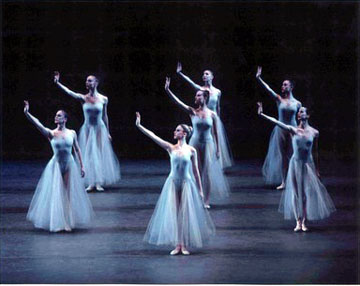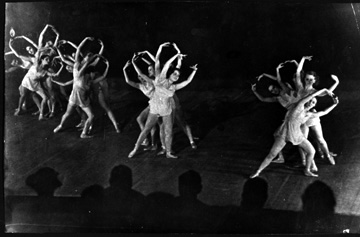Unblocking
the Moonlight:
Reflections on Serenade
by Tom Phillips
copyright
© 2004 by Tom Phillips
published August 9, 2004
 Of
all the tributes to George Balanchine in this centennial year, the most
momentous to my eyes were the performances of "Serenade" by
the School of American Ballet at its annual workshop in June. Seventy
years after Balanchine created his first American ballet for SAB’s
first class of novice performers, today’s world-class students gave
a polished, impassioned account of it to packed audiences at Lincoln Center.
It gave this observer the sense of being present at the creation of something
eternally new, and also the re-creation of a turning point in dance history.
In 1934, "Serenade" was much more than an experimental work;
it was a challenge to the whole conception of dance in America, and the
beginning of a revolution.
Of
all the tributes to George Balanchine in this centennial year, the most
momentous to my eyes were the performances of "Serenade" by
the School of American Ballet at its annual workshop in June. Seventy
years after Balanchine created his first American ballet for SAB’s
first class of novice performers, today’s world-class students gave
a polished, impassioned account of it to packed audiences at Lincoln Center.
It gave this observer the sense of being present at the creation of something
eternally new, and also the re-creation of a turning point in dance history.
In 1934, "Serenade" was much more than an experimental work;
it was a challenge to the whole conception of dance in America, and the
beginning of a revolution.
When Balanchine arrived in America in 1933, in the depths of the Great Depression between the two most destructive wars in history, there seemed little reason for the journey. Bernard Taper writes: “The times could scarcely have been less propitious for an attempt to introduce into the United States so exotic, costly, aristocratic and useless an amusement as ballet. The arts were expected—according to the dominant critical and intellectual attitude of the Depression period—to be committed to the social struggle, to portray life in all its harshness, or at least to be earthy and ‘of the people.’ Classical ballet certainly did not meet any of those conditions. Modern dance seemed closer to the earnest temper of the time.”
The dominant figure in modern dance, of course, was Martha Graham, whose whole career had been a revolt against the ballet tradition. Classical ballet lifted and extended the body toward the heavens; Graham contracted the body and put her dancers into contortions on the floor, as if crushed by a great weight. Likewise the classical pas de deux, with its images of support and adoration of an ideal, was distorted into fleeting, abortive connections between people. An enduring image of Graham’s choreography is of a touch, followed by a convulsive shrinking away, as if the touch conveyed a painful electric shock.
This was the spirit of the times, one that Balanchine was certainly aware of on some level, when he clapped his hands after class one day and announced he wanted to “start something.” With that he began to improvise the first American ballet, a work that addressed both the spirit of the times and fundamental questions about life and art.
 "Serenade"
starts with a tableau that could have been created by Graham. Seventeen
girls stand in blue light, with their feet parallel. One arm is raised,
the hand flexed toward the vertical. Balanchine reportedly told them they
were “blocking the moonlight.” The position is un-balletic,
the expression anti-romantic; but then it is transformed. Suddenly, the
wrist curves and circles overhead, then downward through the center line
of the body, followed by the gaze; the arms form a ballet fifth position
at the hips. Then, without warning or preparation, seventeen pairs of
feet suddenly turn out from parallel to first position. The floor squeaks
in protest. This movement is striking in its abruptness, almost violence.
The point is that it is not an impulse from within, but a discipline imposed
from outside. Graham herself said the first time she saw it, tears sprang
to her eyes. “It was simplicity itself,” she said, “but
the simplicity of a very great master.”
"Serenade"
starts with a tableau that could have been created by Graham. Seventeen
girls stand in blue light, with their feet parallel. One arm is raised,
the hand flexed toward the vertical. Balanchine reportedly told them they
were “blocking the moonlight.” The position is un-balletic,
the expression anti-romantic; but then it is transformed. Suddenly, the
wrist curves and circles overhead, then downward through the center line
of the body, followed by the gaze; the arms form a ballet fifth position
at the hips. Then, without warning or preparation, seventeen pairs of
feet suddenly turn out from parallel to first position. The floor squeaks
in protest. This movement is striking in its abruptness, almost violence.
The point is that it is not an impulse from within, but a discipline imposed
from outside. Graham herself said the first time she saw it, tears sprang
to her eyes. “It was simplicity itself,” she said, “but
the simplicity of a very great master.”
But it’s not yet ballet. The heads are still forward, fixed on the floor, almost like Drosselmeier’s toys, that have to be activated by the master’s magic before the "Nutcracker"’s pantomime turns into ballet. Here, it happens in human form rather than mechanical. The heads lift, the arms rise and spread out in first port de bras, and the torso lifts as the right foot points to the side in battement tendu; the dancers breathe and expand, no longer blocking the moonlight, but open to the world in front of them. It could end here, but it doesn’t. Balanchine – who talked of “forcing” beauty out of human material—closes the feet to a fifth position. The arms again rise and spread, but this time the bodies reach beyond the vertical, rising from the sternum, looking to the sky. “Blocking the moonlight” has been transformed, step by step, into an opening toward the heavens.
Balanchine’s young ballerinas have yet to move from their places, or even bend their knees, but they have already foreshadowed the drama and the history to come: the transcendence of modernism by classicism. Then the dancing begins.
After a 25-minute tour de force of pure ballet, the action literally crashes to earth. A girl comes undone, her hair cascades out of its pins, she crumples to the floor as if shot. Everyone else flees the stage. The image is modernism at its darkest; consciousness is no longer blocked out, it’s blacked out.
Enter a mystery, a mythic procession. A man (perhaps a demi-God) walks on, guided and at the same time blinded by a woman who walks behind him, her hand blocking his vision. He breaks free, and bends to help the fallen girl. She dances with him, vying for him with the dark woman and another dancer who enters. The three fling themselves into his arms in rapid succession. But the drama ends the way it began. The man must yield again to the woman’s arms and her direction. They exit as they entered. The girl sinks to the floor again. She has been left to her fate.
But she has not been left alone. A new group of dancers enters, to perform a ritual of departure, or dedication, or death. It seems they have done this any number of times, maybe for all of eternity. The girl is raised from the floor and wrapped in an embrace, long and warm, by a tall woman. Three strong men, moving as one, kneel, grasp her ankles and lift her straight up. As they bear her away, she raises and spreads her arms, lifts her torso and stretches toward heaven, the same movement that ended the prologue.
 This
was Balanchine’s answer to the despair of modernism, to an age of
blindness and death. For him, even death is communal, and redeemed by
beauty. It’s a Platonic postulate, dear to Balanchine’s heart,
that the world we see is not the real world, that ideal forms lie beyond
our experience, but are available to us in shadowy form. It is the work
of the philosopher—in modern times, the artist— to make those
forms visible. This is classicism, and neo-classicism. The discipline,
the very unnaturalness of ballet is an attempt to go beyond human experience,
to approach a vision of the truth.
This
was Balanchine’s answer to the despair of modernism, to an age of
blindness and death. For him, even death is communal, and redeemed by
beauty. It’s a Platonic postulate, dear to Balanchine’s heart,
that the world we see is not the real world, that ideal forms lie beyond
our experience, but are available to us in shadowy form. It is the work
of the philosopher—in modern times, the artist— to make those
forms visible. This is classicism, and neo-classicism. The discipline,
the very unnaturalness of ballet is an attempt to go beyond human experience,
to approach a vision of the truth.
Such ideas were not exactly fashionable in the 20th century, and they may be even less so in the 21st. But that doesn’t matter. "Serenade" stands on its own. As long as there are beautiful young dancers and a School of American Ballet, its world can be created anew.
Photos:
First: Students of the School of American Ballet in the Elegy from
"Serenade."
Second: Dancers of the New York City Ballet in "Serenade."
Photo: Paul Kolnik.
Third: The premiere of Serenade, given June 10, 1934 on an outdoor
platform at Felix Warburg's estate near White Plains, New York. This was
George Balanchine's first American work and was originally made for students
at the newly founded School of American Ballet. The New York Public Library
for the Performing Arts, Jerome Robbins Dance Division.
Originally
published:
www.danceviewtimes.com
Volume 2, No. 30
August 9, 2004
Copyright
©2004 by Tom
Phillips
|
|
|